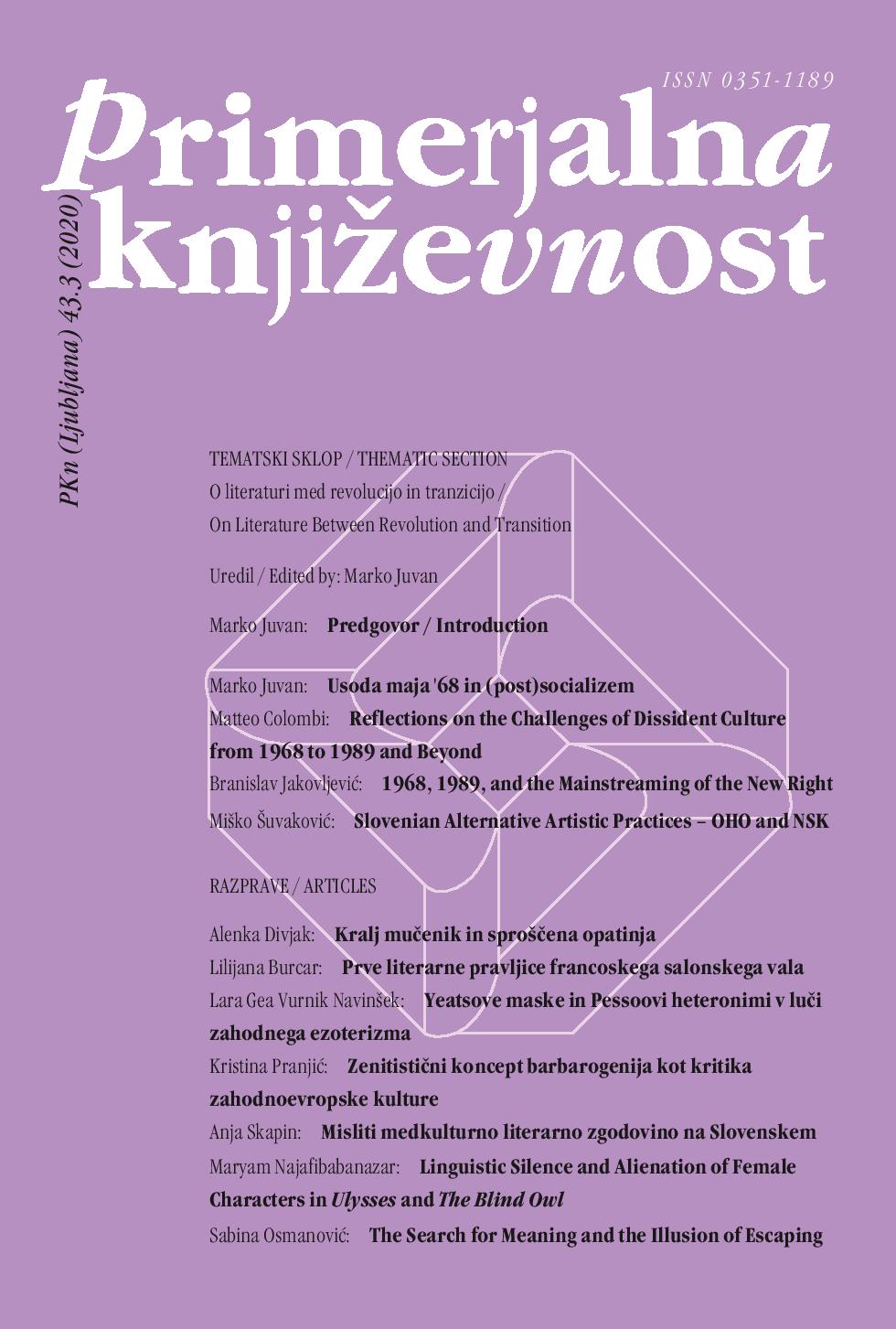Between New Sensibility and Transgression: Slovenian Alternative Artistic Practices – OHO and NSK
DOI:
https://doi.org/10.3986/pkn.v43.i3.04Keywords:
art and society, Slovenian art, neo-avant-garde, post-avant-garde, retro-avant-garde, conceptual art, politics, revolution, OHO, Neue Slowenische KunstAbstract
The article conducts a comparative discussion on the strategic poetic and political similarities/differences between the respective contexts of neo-avant-garde and retro-avant-garde practices in relation to aesthetic, artistic, and cultural revolutions. I juxtapose two revolutionary potentials and effects of their actualisation: the utopias and projections of the international revolution relating to the “new sensibility” and the unity of “art and life” of 1968, and several projects and practices that undermine totalitarian systems, from punk cynicism to the national revolutions of 1989 that overthrew real socialism in the Eastern and Central Europe. In my comparative discussion I focus on two specific cases in Slovenian art and alternative cultures, highlighting the position of “experimental poetry,” “new sensibility,” and “conceptual art” of the OHO group, active between 1966 and 1971, and the position of “political cynicism” and “retro-avant-garde art” in the Neue Slowenische Kunst movement founded in 1984.
References
Arns, Inke. Neue slowenische Kunst, NSK: eine Analyse ihrer künstlerischen Strategien im Kontext der 1980er Jahre in Jugoslawien. Regensburg: Museum Ostdeutsche Galerie, 2002.
Brejc, Tomaž. OHO: 1966–1971. Ljubljana: Študentski kulturni center, 1978.
Brejc, Tomaž. “Obitelj u Šempasu.” Nova umjetnička praksa 1966–1978. Ed. Marijan Susovski. Zagreb: Galerija suvremene umjetnosti, 1978. 19–20.
Brejc, Tomaž. Temni modernizem: slike, teorije, interpretacije. Ljubljana: Cankarjeva založba, 1991.
Britovšek, Marjan, et al. “Prispevki k analizi stalinskega pojava.” Problemi – Razprave 16.177–180 (1978): 113–197.
Čufer, Eda, and IRWIN. “Concepts and Relations (1992).” IRWIN: Zemljopis vremena = Geography of Time. Umag: Galerija Dante Marino Cettina, 1994.
Denegri, Ješa, and Biljana Tomić, eds. Dokumenti o post-objektnim pojavama u jugoslovenskoj umetnosti 1968–1973. Belgrade: Salon Muzeja savremene umetnosti, 1973.
Erjavec, Aleš. “Neue Slowenische Kunst – New Slovenian Art: Slovenia, Yugoslavia, Self-Management, and the 1980s.” Postmodernism and the Postsocialist Condition: Politicised Art under Late Socialism. Ed. Aleš Erjavec. Berkeley: University of California Press, 2003. 135–174.
Erjavec, Aleš, and Marina Gržinić. Ljubljana, Ljubljana. Ljubljana: Mladinska knjiga, 1991.
Gržinić, Marina, et al. Irwin: Zemljopis vremena = Geography of Time. Umag: Galerija Dante Marino Cettina, 1994.
Hall, Stuart, and Tony Jefferson. Resistance through Rituals: Youth Subcultures in Post-War Britain. London: Routledge, 2003.
Iles, Chrissie. “Perceptual Present.” Irwin. London: Riverside Studios, 1987. N. pag.
Kermauner, Taras. Eseji i kritike. Belgrade: Narodna knjiga, 1978.
Lotringer, Sylvère, and Antonio Negri. “A Revolutionary Process Never Ends.” Artforum 46.9 (2008). Web. https://www.artforum.com/print/200805/sylverelotringer-and-antonio-negri-19958
Marcuse, Herbert. An Essay on Liberation. Boston: Beacon Press, 1969.
NSK. “Neue Slowenische Kunst” (special issue). Problemi 23.6 (1985).
NSKSTATE.COM. “NSK State.” Web. 9 March 2008. https://web.archive.org/web/20080309181738/http://www.nskstate.com/state/state.php
OHO. “Članovi grupe OHO” (interview). Treći program 2.4 (1970): 225–235.
Pogačnik, Marko. “Umetnost treće svetlosti.” Katalog 143.3 (1977): n. pag.
Šuvaković, Miško. The Clandestine Histories of the OHO Group. Ljubljana: Zavod P.A.R.A.S.I.T.E., 2010.
Vilić, Nebojša, ed. State – Irwin. Skopje: 359O – Network for Local and Subaltern Hermeneutics, 2000.
Zabel, Igor, ed. OHO: Retrospektiva. Ljubljana: Moderna galerija, 1994.
Zinaić, Milan, ed. Neue Slowenische Kunst. Zagreb: Grafički zavod Hrvatske, 1991.
Žižek, Slavoj. Filozofija skozi psihoanalizo. Ljubljana: Analecta, 1984.


